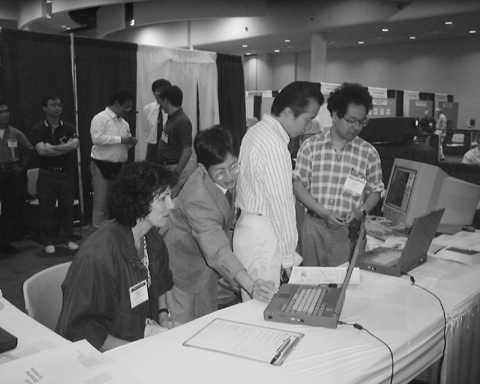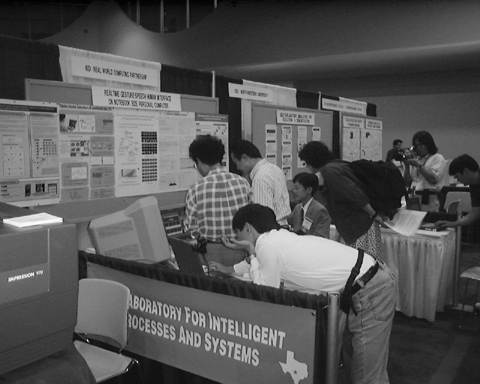
For AAAI-98 run by the Association of American Artificial Intelligence, an academic demonstration was planned for the first time in addition to the technical presentation. To apply for the demonstration, we were requested to submit a video tape to show what it is, as well as a regular paper. We considered this as a good opportunity, so we applied for it and our demonstration was accepted. Our demonstration consisted of 5 demonstration programs implemented on a Notebook PC called MMPC, which showcased our latest results:
1) House design based on real-time spotting recognition of spontaneous speech and gestures. A user can talk with an agent and share the present status of the task displayed by computer graphics.
2) Speech summary based on automatic segmentation of topic from spontaneous speech. The output of the summary is a sequence of speech segments. The program is language-free.
3) Mutual retrieval between speech and video image of TV news data based on self-organized databases and spotting retrieval. The query is an endless stream of speech or video image.
4) Flexible real-time gesture recognition based on a new spotting matching method. About 30 categories of gesture are recognized allowing variations such as stopping or reverse motions.
5) Text retrieval using a large database organized by a non-linear clustering method called Galaxy Clustering Method applied to a set of words from a text database.
For details of the respective programs, please visit the RWCP's WWW at: .
At the demonstration site of AAAI-98, members of the laboratory gave explanations to visitors in turn according to a time table. Visitors appeared to be interested in our demonstration, especially gesture recognition in 1) and 4) above. This is probably because the demonstrations were straight-forward and visitors could take part in them (by performing gestures). I realized that such demonstrations need a sense of entertainment in addition to academic significance.
Next to the demonstration site, a mobile robot contest and human versus computer games such as Go were held at the same time. The robot contest was fought by repeaters from MIT and CMU. The robot contests were held so often that visitors became used to them and enjoyed themselves. I was impressed by SONY's tiny "walking dog robot" and never got bored, and I guess that the variety and functions of such pet robots will increase in the future. A few years from now, robots might mean "pet robots" and might be the first successful commercial products in this category.

Among the Invited Talks at AAAI-98, I was impressed by the following. Daphne Koller (Stanford University) gave a speech titled "Structured Probabilistic Models: Beysian Networks and Beyond", in which she concluded that the success of AI in the past was attributed to stochastic techniques based on databases, rather than logical techniques. However, she maintained that the current stochastic technique lacked structural representation and required some object-oriented framework with Baysian nets as its components. This framework would also incorporate the results of logical techniques in the past and related technologies were also taken into consideration.
Ruzena Bajcy (University of Pennsylvania)'s speech, "When and Where Will AI Meet Robotics ?" (Invited Talk), was also interesting. She (Ms. Bajcy and the above Koller are both female) started her speech by describing the difference in criteria for evaluating researches between the AI industry and the robot industry. The AI industry prefers academic novelty, while the robot industry favors less sophisticated criteria such as functioning one way or the other, improved efficiency, or reduced weight, and that's why they have separated. One important problem in the robot industry is representation so that robots can move around properly in the real world. She showed, as an example, that potential field can be used to represent corridors on a map.
There was an Invited Panel titled "Eight Cool Things from Collected Conferences". This was intended to answer the question "What is the most important recent/experiment/discovery in the area of your conference that the general AI audience doesn't know or understand or appreciate, but should (and why)?" by representatives of eight AI-related international conferences: ILP-98, GP-98, SGA-98, COLT-98, ICML-98, UAI-98, ST&D-98, and CogSci-98. But despite my expectation, they only discussed conventional PAC or VC dimension, and I'd have liked to hear more interesting stories. Perhaps the representatives were not the best choice.

I also attended the AAAI-98 Outstanding Paper Session, where the following three papers were selected:
"Learning Evaluation Function for Global Optimization and Boolean Satisfiability," by Justin A. Boyan and Andrew W. Moore (CMU);
"The Interactive Museum Tour-Guide Robot," by Wolfram Burgard (University of Bonn) et al.; and
"Acceleration Methods for Numerical CSPs," by Yahia Lebbah and Oliver Lhomme (Ecole des Mines de Nantes, France).
The first paper proposed a method to reduce the amount of computation in search or optimization problems by learning evaluation functions from the search path, supported by such examples as pin-packing, channel routing, Bayes net, radiotherapy, cartogram, and satisfiability. The second paper addressed the creation of guidance robots for museums which was actually operated for 47 hours (navigation for 18.6 km, 2000 guides, 600 Web-based visitors). It featured a laser as its primary sensor. The third paper proposed a method to speed up the convergence of numerical values in CPS. I was impressed by all of them that considered practical use.
Acknowledgment: Our demonstration would not have been successful without the help of Nozaki, Cho, and Yamashita, from Media Drive Laboratory.